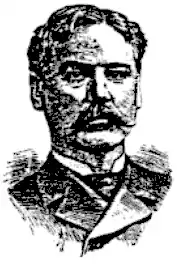Charles DeKay
Charles Augustus de Kay (July 25, 1848 – May 23, 1935) was a linguist, poet, critic, and fencer. He was a son of George Coleman De Kay, a naval officer.[2] He was best known for founding the National Arts Club and the Fencers Club.[1] He was inducted into the United States Fencing Hall of Fame in 2008. He was an art and literary critic for The New York Times for 18 years.
Charles de Kay | |
|---|---|
 | |
| Born | Charles Augustus de Kay July 25, 1848[1] |
| Died | May 23, 1935 (aged 86)[1] |
| Alma mater | Yale[1] |
| Spouse(s) | Edwardlyn Coffey[1] |
| Children | Drake, Rodman, Ormonde, Helena, Janet |
| Signature | |
He was buried in Saint George's Church Cemetery, Hempstead, Nassau County, New York.[3]
Writing
- The Bohemian (New York, 1878)
- Hesperus (1880)
- Vision of Nimrod (1881)
- Vision of Esther (1882)
- Love Poems of Louis Barnaval (1883).
- Bird Gods, with an accompaniment of decorations by George Wharton Edwards. New York : A.S. Barnes (1898).[4]
According to Appletons' Cyclopædia (1900), his best-known story is "Manmatha".[2]
References
| Wikisource has original works written by or about: Charles DeKay |
- "Brief Biography of Charles deKay" Archived July 17, 2011, at the Wayback Machine, United States Fencing Hall of Fame website. Retrieved on December 02, 2010.
- Wilson, J. G.; Fiske, J., eds. (1900). . Appletons' Cyclopædia of American Biography. New York: D. Appleton.
- "Charles Augustus DeKay". findagrave.com. Retrieved February 10, 2020.
- De Kay 1898: OCLC 1065202268 (all editions) (see also: OCLC 1087093329 (all editions) etc.); digital copy at Internet Archive; digital copy at University of Michigan.
External links
- Works by Charles DeKay at Project Gutenberg
- Works by or about Charles DeKay at Internet Archive / Works by or about Charles DeKay at Internet Archive
- Works by Charles DeKay at LibriVox (public domain audiobooks)

- Louis Comfort Tiffany and Laurelton Hall: an artist's country estate, an exhibition catalog from The Metropolitan Museum of Art Libraries (fully available online as PDF), which contains material on DeKay
This article is issued from Wikipedia. The text is licensed under Creative Commons - Attribution - Sharealike. Additional terms may apply for the media files.